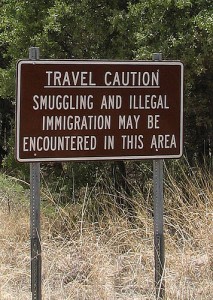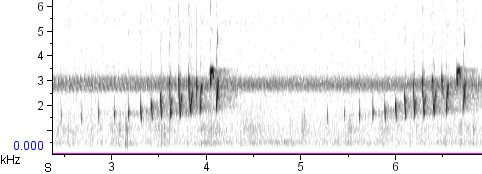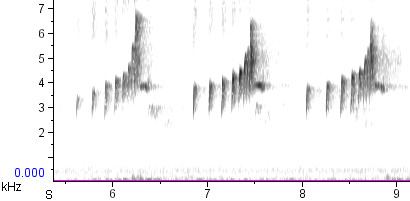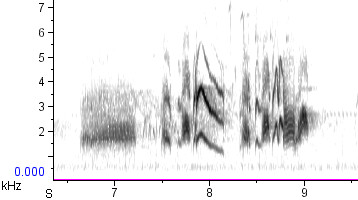Rattles, Claps, & Burp-clicks
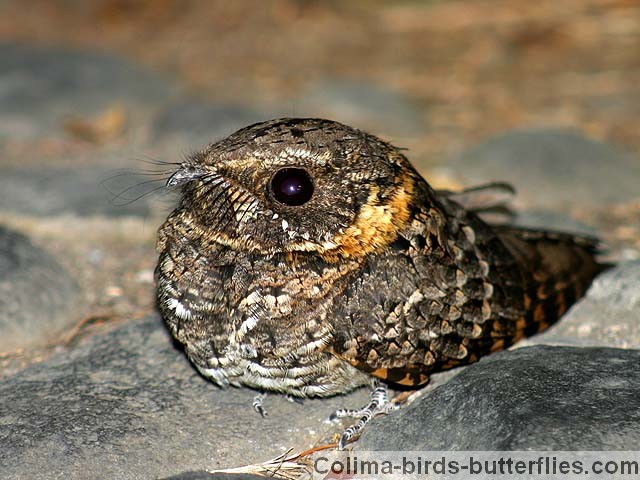
Perhaps the single species I most wanted to audio record on my recent trip to Sonora was the Buff-collared Nightjar. I posted last year about the mystique of hearing this bird north of the Mexican border, where it is extremely local and rare. In southern Sonora, by contrast, it is abundant, and I heard its préstame-tu-cuchillo song every single night of the trip.
Although the song of the species is well known, its other sounds are not. The Birds of North America account on this species says “Calls, typical of genus, are various chuck or clucking notes; and quirr. Calls very similar to those given by Whip-poor-will. No known recordings of calls. Female known to give only chuck calls or clucking; no song. … Not known to wing-clap as other caprimulgids do.” Howell and Webb’s Mexican field guide says that calls include “a low, clucking chuuk and kruk kruk, kruk…, and harder, clucking chatters.” These descriptions give the impression that Buff-collareds may have a pretty impressive call repertoire, but without recordings, of course, it’s difficult to be sure.
I am pleased to share with you a couple of cool audio clips that may help resolve (or perhaps merely deepen) the mysteries surrounding the calls of the Buff-collared Nightjar. The first was recorded in 1986 and resides in the archives of the Macaulay Library. It was recorded by Geoff Keller, one of the foremost nature sound recordists in America, and the first four minutes of it are probably the finest recording I’ve heard of Buff-collared’s primary song.
Right at the end of the cut, something remarkable happens:
(Click here to hear the original)
The first time I heard this, I thought that Geoff’s microphone had rolled downhill right in the middle of one of the bird’s song strophes. It sounded like a mechanical failure of the sound equipment. But after listening carefully a second time, I realized that the crickets in the background keep chirping undisturbed throughout the disturbance and after. I did a little research and discovered that Curtis Marantz, another fine sound recordist, had listened to the same cut before me and added some notes to Cornell’s database: “The recording concludes with what appears to be a series of wing-claps and some clucking or clicking calls (if not a noise produced by the wings).”
At first I was somewhat skeptical of this claim, since wing-clapping hadn’t been reported from the species, and also because of the bizarre nature of the sound, which alternated low “claps” with higher “rattles.” But then I contacted Geoff Keller by email to ask him about the circumstances surrounding this recording, and he replied:
You have hit upon one of my most memorable recordings of my entire career…. As for the sounds at the end of the recording, I too agree they are wing-claps. I have now since heard many similar wing-clap sounds from other members of the Nightjar family.
Even more interesting is what Geoff witnessed after the end of the recording:
After the bird ended his series of territorial calls, the presumed male flies away (that is when the wing-claps are heard). However, the bird wasn’t finished. It circled around and landed once again just a few meters in front of me. There apparently was a female present, and the two nightjars began yet another series of most unusual sounds, which almost certainly would have been courtship vocalizations. This series of vocalizations were very different from the display/advertisement call of the male … I seem to remember “purring sounds” and “gurgling” like noises. I am presuming there was a female close by in the darkness, but I do not really know for sure. I do know for certain that the nightjar was unaware of my presence, as I had been holding tight under the cover of a mesquite tree for many minutes, and had entered this position while the bird was calling from the opposite end of his breeding territory some 100 meters away.
Unfortunately, we don’t have recordings of the courtship sounds that Geoff heard in the field that night. But when I was in southern Sonora, I had my own remarkable encounter with a Buff-collared Nightjar, which resulted in another interesting recording.
It was about 9:00 PM, quite a while after sunset, and my Mexican guide Rene and I were hiking by headlamp down a trail through some scrubby forest on the north slope above Rancho Santa Barbara. We had just stopped to listen (successfully) for Spotted Owls, and I had my recording equipment ready to go, although it was turned off, when Rene came around a corner and a bird flew up in front of him, clucking and growling. I immediately recognized the vocalizations of a nightjar, as I’d heard similar sounds from Common Poorwills and Mexican Whip-poor-wills in distraction displays. I turned my recorder on, and as I did so, the bird flew away from Rene and closer to me — landing about 10 feet in front of me on the path. It took me a couple of seconds to find it in the headlamp and point the microphone at it properly, and during that time it made a bizarre series of quiet sounds, alternating burps and clicks and low gulps. When I finally got a look at the bird in the headlamp, I had just a moment to marvel at how obvious the buff collar really was. For these few seconds (the second half of the recording below), the bird was sitting on the ground without visibly moving, so it definitely was not making any of these sounds by wing-clapping. Then it flew off at the end the way it had flown in, with a couple of gruff clucking calls.
Over the next week, I tried many times to record more calls from Buff-collared Nightjars, but I had scant luck. However, I did hear these odd burp-clicks again on a number of occasions, from many different individuals — always at the beginning of a song bout. When a male nightjar was about to start singing for an extended period, he would give a series of these burp-clicks for about 10 seconds, which would lead right into the first rendition of his normal song. After that, he would repeat the song for a long time without any calls in between — only the first song in each bout had the special introductory notes.
Perhaps the most interesting thing about what I recorded is that when I asked Geoff Keller to listen to it, he didn’t seem to think it was a very good match for the presumed courtship sounds he heard in 1986. In other words, the species probably makes even more sounds than can be heard on this page. Geoff’s recording and mine, I think, establish Buff-collared Nightjar as by far the most vocally versatile nightjar in the western United States — but that’s just based on the tiny bit we know of it. What else do Buff-collareds say?
If ever there was a bird I desperately wanted more recordings of, this is surely it.
